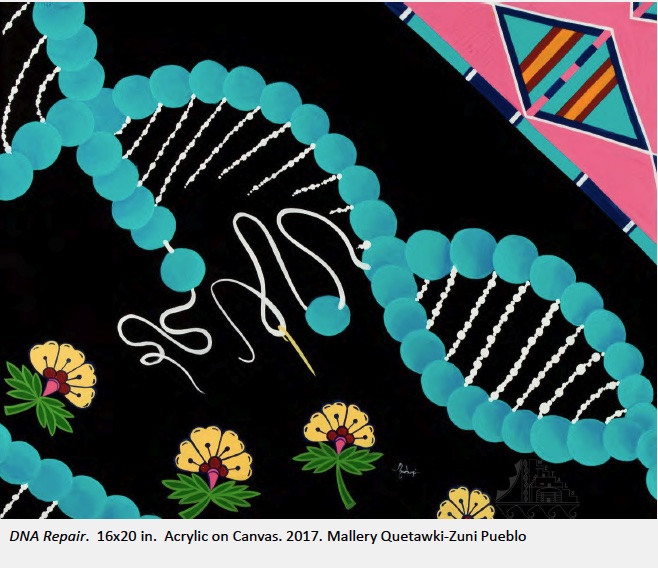Three ongoing Bio Projects are geared toward understanding how environmental metals interact with and affect human bodies when ingested or inhaled, especially within the immune system, lungs, and the gut.
The aim of these projects is to mitigate damaging effects of these metals by understanding cellular mechanisms of toxicity and seek to identify effective interventional strategies.

Laurie G. Hudson, PhD
Debra MacKenzie, PhD
Esther Erdei, PhD
David Begay, PhD
Erica Dashner-Titus, PhD
Partnering with Native American communities, the UNM Metals Exposure and Toxicity Assessment on Tribal Lands in the Southwest (UNM METALS) team has obtained evidence for community level exposures and health risks associated with more than 1100 abandoned uranium mine (AUM) waste sites on their tribal lands. Biomonitoring results confirm that community members are exposed to uranium and other metals beyond national norms, leading to community concerns about potential impact on health.
This project addresses Native American community concerns about health effects associated with exposure to uranium and co-occurring metals found at legacy uranium mining waste sites. Our studies will investigate the biologic consequences of mixed metals exposure in impacted communities. We will use biomonitoring to assess current exposures to mixed metals and metalloids. Based on preliminary findings and published work, we will test the hypothesis that exposure to the unique mixtures of environmental metals associated with abandoned uranium mines promotes oxidative stress and inflammatory responses, processes known to promote immune dysregulation and development of numerous chronic diseases. Complementary studies in experimental models are designed to identify mechanisms of toxicity that can be targeted for future population-based interventions.
This project is responsive to community concerns and the outcomes are expected to 1) provide insights into biological consequences of understudied toxic metals identified in environmental samples and elevated in biospecimens from the community, 2) expand mechanistic knowledge of the impact of specific metals and metal mixtures as well as the basis for metal interactions in human immune cells, and 3) experimentally test the potential of mechanism-based interventions to confer protection from environmental metal exposures. Our ultimate goal is to leverage mechanistic science toward development of interventional clinical trials to mitigate the health risks of ongoing metals exposures.
Eliseo F. Castillo, PhD, Division of Gastroenterology & Hepatology, Department of Internal Medicine, UNM HSC
Julie G. In, PhD, Division of Gastroenterology & Hepatology, Department of Internal Medicine, UNM HSC
Abandoned uranium mines (AUMs) are concentrated in the Southwestern United States, with many on tribal lands. The Native American communities surrounding AUMs have voiced their concerns that uranium (U) and arsenic (As) exposures arising from AUM sites have increased the prevalence of chronic and systemic diseases, including immune dysfunction and cancer. Our previous research on environmental metal exposure focused on cardiovascular and pulmonary effects; however, realizing that inhalation intake strongly contributes to gut exposure through contaminated mucus ingestion, we are interested in gastrointestinal (GI) health. Additionally, the GI tract is also readily exposed to environmental metals through contaminated food and water sources. Thus, the ultimate goal of these studies is to address community concerns regarding exposure to mixed metals from AUM waste and other hard metal mines leading to potential immunologic changes and diseases originating from the GI tract.
The researchers for BP Gut are experts in gut biology and immunology and intend to determine how these environmental metals affect three aspects of the gut. There is a tripartite interaction involving the microbiota (microorganisms living in our gut), the immune system, and the intestinal epithelium which maintains the balance between intestinal homeostasis and inflammation. Dysfunction in one of these components can have profound effects on the other two systems as well as systemic health. Therefore, we will utilize animal models and human intestinal organoids to decipher how gut exposures to environmental pollutants disrupts GI health.
Chronic exposure to metal mixtures from AUM wastes have been linked to increased risk for diseases including hypertension, diabetes, autoimmunity, and kidney disease in adult studies. This disproportionally affects Native American communities in the Southwestern United States. Our work will provide critical mechanistic insights into the potential immunotoxicity of U and As in GI physiology and disease pathophysiology.
Alicia Bolt, PhD
Sarah Blossom, PhD
Katherine Zychowski, PhD
Inhalation of mine site dust is a potential route of human exposure to metal mixtures that poses a significant health concern for tribal communities living near abandoned uranium and hard rock mine sites in the four-corners region of the Southwestern United States. Persistent lung inflammation is associated with multiple immune-mediated inflammatory disorders including autoimmune disease. However, the contribution and extent of inhaled mine site-derived metal particles to immune dysregulation and the development of autoimmunity is unknown.
One hypothesis of this project is that mine site dust containing metal particles drives lung and systemic immune dysregulation and autoimmunity through the hyperactivation of neutrophils. Our initial studies, using autoimmune prone mice, suggest that inhalation exposure to mine site dust leads to the hyperactivation of neutrophils resulting in the formation of neutrophil extracellular traps (NETosis), which is an important driver of pulmonary inflammation. Using advanced cell and mouse models, as well as health studies in exposed populations, our research team is investigating the role of activated neutrophils and NETosis in the development of lung and systemic immune dysregulation following mine site dust exposure.
Information gained from this project will provide novel insight into the potential risks associated with exposure to airborne metals and their role in metal-mediated immune modulation and disease.